In February 2003, Society presidents endorsed a research project
that would, for the first time, survey all IEEE Societies. This
project was named, “IEEE All Society Research Project.”
Dr. Elena Gerstmann, Director, IEEE Research-Corporate Strategy
and Communications, coordinated the project. Each Society appointed
a point of contact (Socpoc) to work on this project. The Socpoc
team, via email, oversaw the processes. This team included one
person from each Society, a staff member from each of the IEEE
Regional Activities Department and the Technical Activities Department,
and the two-person IEEE Research staff. I had the honor of being
among the Socpoc and other team members for this research project.
Each Socpoc customized the questionnaire for his or her own Society,
the result being a very comprehensive set of questions covering
every conceivable aspect of the IEEE and its Societies. By the
way, Dr. Gerstmann and her staff of two did an outstanding job
at preparing an online survey questionnaire, and collecting and
reducing an enormous wealth of data from the survey.
The goals of this project were to provide each Society with membership
information in order to: plan for the future; measure membership
satisfaction with each Society and the IEEE; develop strategies
for membership growth and retention; assess the value and importance
of existing programs and services (publications, conferences,
websites, etc.) and of membership, in general; highlight “hot”
content areas; and determine membership demographics (employment
status, industry, years of professional experience, etc.). I believe
that the project achieved its goal by providing very useful information
that will be folded into our long range planning for the EMC Society.
The sample population reflected higher-grade Society membership
(Associates, Fellows, Members, and Senior Members; no Life members
or Students) focusing on members with an email address on file
(Note: about 88 percent of IEEE members have an email address
in the IEEE member database). Approximately 1,100 members were
randomly selected per Society. A sampling plan was developed that
assured that a member would only receive one questionnaire regardless
of how many Society memberships she or he held. Comparisons between
the randomly drawn sample and the populations were made to ensure
representative samples. Data collection began in early June 2003.
An additional sample of 1,800 IEEE non-Society members was sent
a similar survey.
A total of 406 EMC Society members actually participated in the
survey. Estimating that 1,100 email invitations were delivered,
the response rate was 37 percent. These responses were determined
to constitute a representative sample because the sample was randomly
drawn and was representative of the population of EMC Society
members with email addresses. Given that, the margin-of-error
was within ±5 percent with a 95 percent degree of confidence.
The results presented in this report can be generalized to the
population of EMC Society members with high confidence, but with
the knowledge that the results may be skewed because (a) more
members from the US were asked to participate than in the population
of EMC Society members at large (57% vs. 52%), and (b) members
with only one Society membership were asked to participate than
in the population of EMC Society members at large (44% vs. 33%).
Detailed Findings
The survey results are broken down into the following eight categories:
1) Membership issues
2) Web sites and educational opportunities
3) Symposia/Conferences
4) Publications
5) Content coverage
6) EMC Chapters
7) Volunteering
8) Demographics
The results are presented below in graph form. The survey question
precedes the graphed results. For the sake of brevity, a comment
on the bottom line of the results of the survey for each category
and question is provided. The graphs are generally sorted from
high to low. For evaluation-type questions (e.g., satisfaction),
percentages displayed in the graphs are based only on those members
who indicated a level of satisfaction and do not contain those
who indicated “not aware,” or the equivalent.
I point out that the online survey is only one tool for measuring
membership satisfaction, but an excellent barometer for determining
what we are doing well and perhaps where improvements could be
made in our membership program. On the other hand, we more often
rely on surveys conducted at our annual symposium and on a comprehensive
EMC Society survey that is conducted approximately every five
years. These surveys are very well focused and allow us to periodically
pulse our members in the short term. But, more about these other
survey tools a little later.
Membership Issues
This series of survey questions asks respondents to rate the quality
and usefulness of IEEE and EMC Society membership benefits.
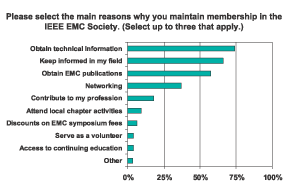
Bottom Line: Our members are interested primarily in maintaining
their membership in order to obtain technical information, keep
current with the EMC discipline, and receive EMC publications.
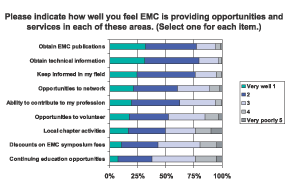
Bottom Line: We seem to be doing a good-to-excellent job
in providing benefits to our members; namely, with regard to publications,
technical information, and keeping members informed of developments
in the EMC field.
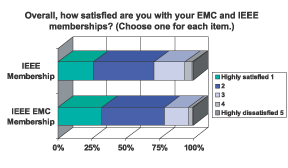
Bottom Line: The vast majority of members who responded
are very-to-highly satisfied with both their IEEE and EMC Society
memberships.
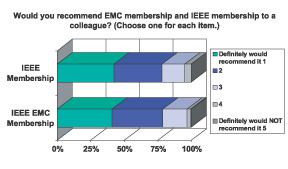
Bottom Line: The vast majority of current members would
very likely or definitely recommend others to join the IEEE and
EMC Society.
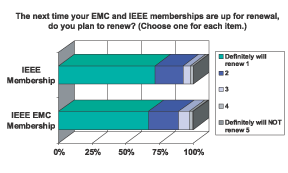
Bottom Line: The vast majority of current members plan
to renew their membership.
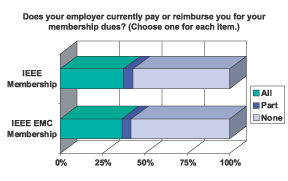
Bottom Line: Most employers do not underwrite the cost
of IEEE or EMC Society membership dues for their workers.
Websites and Educational Opportunities
The following set of survey questions and results pertain to the
use of EMC-oriented web sites and online educational tools by
our members.
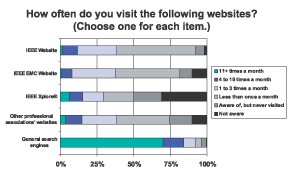
Bottom Line: Approximately, on average, members visit the
IEEE and EMC Society Web Sites about once a month.

Bottom Line: Most members feel that the
EMC Society should offer more electronic educational products
and provide more online educational opportunities.
Conferences
The next set of results focus on the number of technical conferences,
meetings, or workshops that members attend in a typical two-year
period. Based on the sample responses, the Mean=4.24; Median=3;
Mode=2; and Range = 0 to 41 (for all you statisticians out there!).
Regarding attendance at conferences sponsored or co-sponsored
by the EMC Society, the following statistics were borne out of
the survey (statisticians, beware!): Mean=1.71; Median=1; Mode=0;
Range = 0 to 20.
For conferences sponsored or co-sponsored by another IEEE Society
(not EMC), the following were determined: Mean =0.95; Median=0;
Mode=0; Range = 0 to 20.
For conferences not sponsored or co-sponsored by the IEEE or an
IEEE Society, the statistics were: Mean=1.68; Median=1; Mode=0;
Range = 0 to 23.
Finally, for conferences in which it is uncertain what organization
sponsors, the results were: Mean = 0.46; Median=0; Mode=0; Range
= 0 to 10.
Additional survey results are graphically shown next.
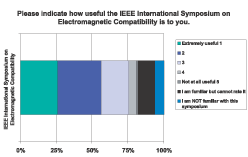
Bottom Line: The vast majority considers the annual EMC
symposium to be moderately-to-extremely useful.
Publications
The next series of questions pertain to the quality and usefulness
of IEEE and EMC Society publications (IEEE Spectrum, The Institute,
EMC Society Newsletter, EMC Transactions, and EMC Symposium Proceedings).

Bottom Line: All main IEEE and EMC Society publications
appear to be very-to-extremely useful (especially the EMC Symposium
Proceedings, EMC Transactions, and IEEE Spectrum).
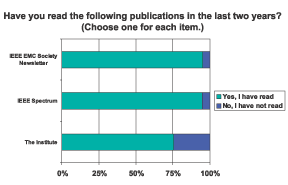
Bottom Line: The vast majority of our members read the
EMC Society Newsletter and the main IEEE publications.
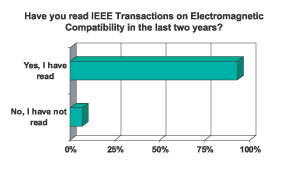
Bottom Line: The vast majority of our members read the
EMC Transactions.
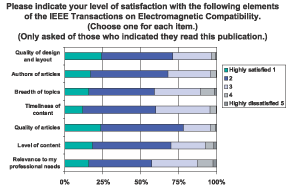
Bottom Line: The vast majority of our members are satisfied
with the overall quality and content of the EMC Transactions.
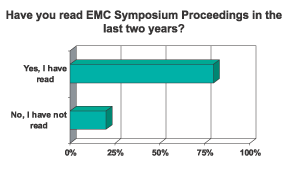
Bottom Line: A majority of our members read the EMC Symposium
Proceedings.

Bottom Line: The vast majority of our members are satisfied
with the overall quality and content of the EMC Symposium Proceedings.
Content Coverage
This category explores the diversity of topics contained in our
EMC Society publications.
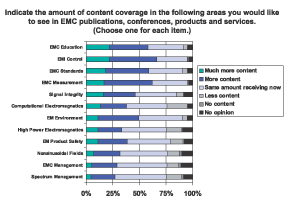
Bottom Line: Generally, members would like to see more
content primarily on topics related to EMC education, EMI control,
EMC standards and measurement; although more content on other
topics is also desirable.
EMC Chapters
This category refers to the participation by members in EMC chapter
activities and meetings.
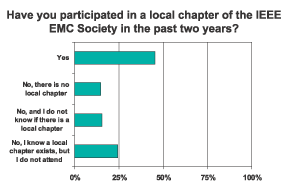
Bottom Line: A majority of members have not participated
recently in chapter activities for various reasons.
Volunteering
The next series of questions delves into how familiar and how
satisfied members are with regard to volunteer opportunities on
behalf of activities sponsored by the EMC Society and EMC Chapters.
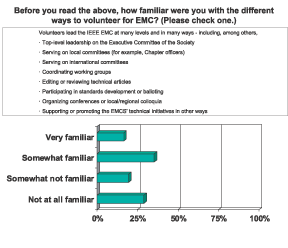
Bottom Line: There appears to be about an even split of
members who are aware of volunteer opportunities and those who
are not.
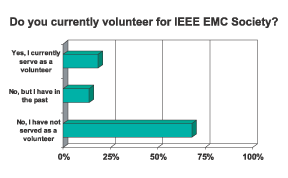
Bottom Line: A significant majority of members do not volunteer
on behalf of EMC Society activities.

Bottom Line: The majority of members who currently volunteer
in support of EMC Society activities are satisfied to highly satisfied
with their volunteer work.
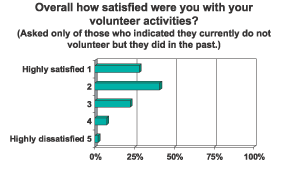
Bottom Line: The majority of members who volunteered in
the past in support of EMC Society activities were satisfied to
highly satisfied with their volunteer work.
Demographics
Of the survey respondents, the statistics on the number of years
of professional experience were, Average = 19.63 years; Median
= 19 years; Mode = 15; and Range = 2 to 45. The breakdown is shown
below.
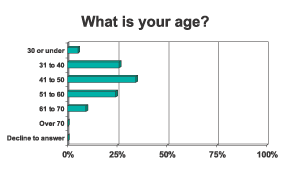
Bottom Line: The majority of survey respondents were 30+
years of age.
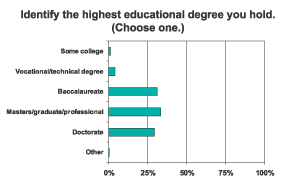
Bottom Line: The majority of respondents had a Bachelor
degree or higher.
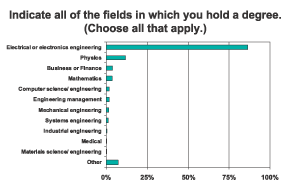
Bottom Line: The vast majority of respondents have one
or more degrees in electrical or electronics engineering followed
by physics and other degrees.
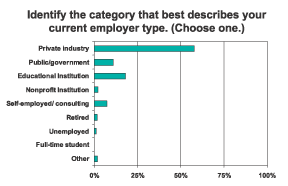
Bottom Line: The majority of respondents work in private
industry, educational and public/government institutions, and
are self-employed.
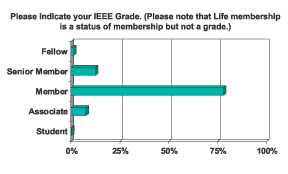
Bottom Line: The majority of respondents with higher-grade
membership are regular IEEE members.
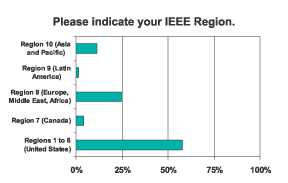
Bottom Line: The majority of respondents are from IEEE
Regions 1-6, followed by Regions 8 and then 10.

Bottom Line: The majority of respondents belong to 3 or
less IEEE Societies (approx. 40% are just EMC Society members).
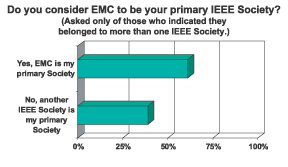
Bottom Line: The majority of respondents who stated that
they belong to more than one Society consider EMC to be their
primary Society.
The “Bottom Bottom Line”
Overall, we seem to be doing quite well in providing products,
services, and other tangible as well as intangible benefits to
our members at large, but there is always that proverbial “room
for improvement.” In particular, we need to do a better job
at offering satisfying volunteer opportunities at the Chapter
level. We also must help to grow new chapters, which, in turn
will lead to such new opportunities. Also, we should develop closer
ties to industry through cooperative incentive programs between
the IEEE and employers to promote industry support of memberships
for their employees. There are other strategies and best practices
we could and will consider in the coming months and years.
Where Do We Go From Here?
In order to build upon and leverage the results of the present
IEEE study, we will continue to conduct periodic surveys at the
annual EMC Symposium. This has been done masterfully in the past
by Dick Ford and will now fall on the shoulders of our colleague
Fred Heather. Additionally, we will be sponsoring a five-year
Society survey in 2004, which is intended to delve even deeper
into the various survey categories and questions covered in this
report.
I hope you found the results of this survey as interesting and
useful as I did. If you have any comments or suggestions, please
drop me a line. I will collect your ideas and give them serious
consideration as part of our long range planning. EMC
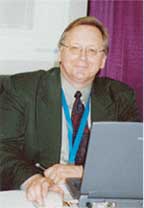 IEEE
All Society Research Project 2003
IEEE
All Society Research Project 2003



























